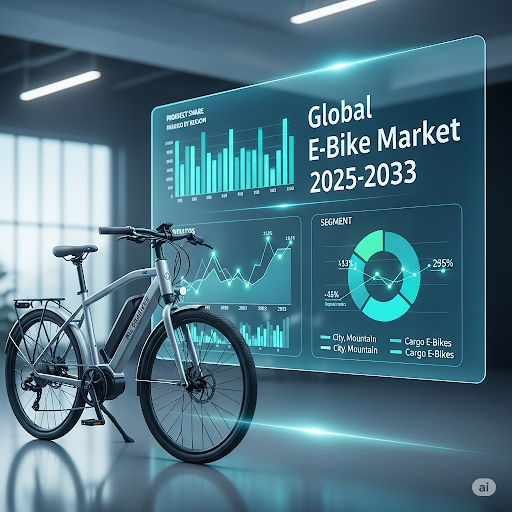E-Bike Market Size, Share, Trends and Forecast: Key Growth Drivers Revealed to 2033

MARKET OVERVIEW
The global e-bike market was valued at USD 26.4 billion in 2024 and is projected to reach USD 45.5 billion by 2033, driven by urbanization, government incentives, improved battery tech, and rising demand for affordable, low-emission commuting options. The market is set to grow at a 6.22% CAGR (2025–2033) as consumers adopt pedal-assist and connected e-bikes for daily mobility and leisure.
STUDY ASSUMPTION YEARS
- BASE YEAR: 2024.
- HISTORICAL YEAR: 2019–2024.
- FORECAST YEAR: 2025–2033.
E-BIKE MARKET KEY TAKEAWAYS
- Global market size was USD 26.4B (2024) and is forecast to reach USD 45.5B (2033) at 6.22% CAGR (2025–2033).
- Asia Pacific dominates the market, holding ~76.6% share (2024) due to manufacturing scale and supportive policies.
- Pedal-assist leads by mode, preferred for fitness and commuting (66.9%).
- Hub motors are the top motor type (63.6%), favored for low cost and easy maintenance.
- Lithium-ion batteries dominate (68.6%), powering longer range and reliability improvements.
MARKET GROWTH FACTORS
Technological Advancements & Battery Improvements
The ongoing advancements in battery chemistry, management systems, and motor designs are driving significant growth in the e-bike market. Lithium-ion batteries, which dominate the market, have seen improvements in energy density and cost, allowing for longer ranges and quicker charging—perfect for those early adopters who worry about running out of juice. Manufacturers are now incorporating smarter battery management systems, torque sensors, and app connectivity to enhance the pedal-assist experience, boost performance, and offer predictive maintenance features. These tech upgrades enable companies to provide a broader range of products, from lightweight city bikes to high-performance mountain e-bikes, appealing to a wider audience. As battery suppliers ramp up production and component prices drop, original equipment manufacturers can roll out competitive mid-range and premium models, attracting both urban commuters and recreational riders. This variety in products and performance enhancements is expected to drive the market's growth to an impressive USD 45.5 billion by 2033.
Regulatory Support & Policy Incentives
Government policies and financial incentives are really boosting the popularity of e-bikes around the globe. Many countries and local governments are stepping up with subsidies, tax breaks, and investments in infrastructure to encourage electric mobility and cut down on urban emissions. These initiatives not only make e-bikes more affordable but also expand the market—especially in densely populated areas of the Asia Pacific, where supportive regulations and production capabilities have led to widespread adoption. Urban planning that adds more bike lanes and weaves micromobility into public transport systems creates more opportunities for e-bikes to serve as effective first- and last-mile solutions. Legislative efforts to standardize e-bike classifications and registration (where needed) enhance rider confidence and safety, while also paving the way for insurance and corporate mobility programs. This policy momentum helps break down barriers to adoption, complements private sector product launches, and strengthens long-term demand, all contributing significantly to the projected 6.22% CAGR.
Market Demand & Socioeconomic Drivers
The rise of urban living, traffic jams, and a growing awareness of health and environmental issues are changing how people choose to commute, with e-bikes becoming increasingly popular. With fuel prices on the rise and the demand for quick, affordable transportation, e-bikes are proving to be a smart choice for short to medium commutes, especially in crowded cities. Consumers are leaning towards pedal-assist and city/urban models, which dominate the market because they offer a great mix of exercise and convenience. Plus, the growth of e-commerce, rental services, and corporate wellness initiatives is making e-bikes more accessible and encouraging new riders to give them a try. An older population in certain areas is also turning to e-bikes for greater mobility and independence, expanding the range of users. All these social and economic factors are driving consistent growth in the e-bike market and painting a positive picture for its future.
Request for a sample copy of this report: https://www.imarcgroup.com/e-bike-market/requestsample
MARKET SEGMENTATION
Analysis by Mode:
- Throttle — E-bikes with throttle control allow the rider to propel the bike without pedaling, suited for short commutes and users seeking fully assisted rides.
- Pedal Assist — Bikes that provide electric assistance only when pedaling, combining exercise with motor support; widely adopted for commuting and recreational use.
Analysis by Motor Type:
- Hub Motor — Motors integrated into the wheel hub offering quiet, low-maintenance operation and cost advantage; ideal for city and foldable e-bike designs.
- Mid Drive — Motors mounted near the crank delivering better hill performance and balanced weight distribution; favored for performance and trekking e-bikes.
- Others — Includes alternative or hybrid motor configurations and emerging drive systems used in niche or specialized e-bike models.
Analysis by Battery Type:
- Lead Acid — Older, lower-cost battery tech with higher weight and lower energy density; used in budget e-bike applications where cost is critical.
- Lithium Ion — Dominant battery chemistry with high energy density, longer life, and better performance, driving mainstream e-bike adoption globally.
- Nickel-Metal Hydride (NiMH) — An intermediate technology offering better performance than lead acid but lower energy density than lithium-ion; used in select models.
- Others — Emerging battery types or proprietary chemistries under development for specific performance or cost goals in e-mobility.
Analysis by Class:
- Class I — Pedal-assist only e-bikes that assist while pedaling up to a specified speed; closely resemble conventional bicycles and are highly popular.
- Class II — E-bikes with throttle and pedal capabilities providing full assistance without pedaling, suitable for riders seeking convenience.
- Class III — Higher-speed pedal-assist models designed for faster commuting; often subject to different regulations and preferred for performance commuting.
Analysis by Design:
- Foldable — Compact, portable e-bikes engineered for storage and multimodal commutes, ideal for last-mile solutions and commuters with limited space.
- Non-Foldable — Traditional frame e-bikes with greater structural stability and durability, preferred for daily commuting and diverse terrains.
Analysis by Application:
- Mountain/Trekking Bikes — Sturdy e-bikes built for off-road conditions and long rides, focusing on suspension, torque, and battery durability.
- City/Urban — Purpose-built for congested urban travel, offering comfort, range, and convenience for daily commuting; largest application share.
- Cargo — Designed to carry goods or passengers with reinforced frames and higher load capacities, widely used for deliveries and utility tasks.
- Others — Specialised or niche applications including leisure, fishing, or customized utility e-bikes not covered by other categories.
Breakup by Region:
• North America (United States, Canada)
• Asia Pacific (China, Japan, India, South Korea, Australia, Indonesia, Others)
• Europe (Germany, France, United Kingdom, Italy, Spain, Russia, Others)
• Latin America (Brazil, Mexico, Others)
REGIONAL INSIGHTS
Asia Pacific dominates with roughly 76.6% market share (2024), driven by dense urban populations, strong local manufacturing (notably China), government subsidies, and rapidly expanding middle-class demand. Large production scale and targeted policy support have reduced unit costs and accelerated adoption across commuter and cargo segments.
RECENT DEVELOPMENTS & NEWS
Recent activity highlights product launches and market re-entries: Decathlon introduced the RR900e with Bosch drive and smartphone integration (April 2024), demonstrating mainstream OEM focus on performance and connectivity. Hero Lectro expanded its e-cycle lineup in India (H4, H7+), targeting price-sensitive consumers with modern features (April 2024). Posco Daewoo signaled intentions to re-enter India’s e-mobility market, indicating renewed investor confidence. Battery players like Amara Raja are scaling lithium-ion operations for international markets. Collectively, these moves emphasize better battery life, connected features, and competitive pricing, broadening consumer choice and accelerating adoption.
KEY PLAYERS
- AIMA Technology Group Co., Ltd.
- Giant Manufacturing Co., Ltd.
- Kalkhoff Werke GmbH
- Merida Industry Co., Ltd.
- Pedego Inc.
- Riese & Müller GmbH
- Specialized Bicycle Components, Inc.
- SUNRA (Jiangsu Xinri E-Vehicle Co., Ltd.)
- Trek Bicycle Corporation
- Yadea Technology Group Co., Ltd.
Ask Analyst for Customization: https://www.imarcgroup.com/request?type=report&id=1604&flag=C
If you require any specific information that is not covered currently within the scope of the report, we will provide the same as a part of the customization.
About Us:
IMARC Group is a global management consulting firm that helps the world’s most ambitious changemakers to create a lasting impact. The company provides a comprehensive suite of market entry and expansion services. IMARC offerings include a thorough market assessment, feasibility studies, company incorporation assistance, factory setup support, regulatory approvals and licensing navigation, branding, marketing and sales strategies, competitive landscape, and benchmarking analyses, pricing and cost research, and procurement research.
Contact Us:
IMARC Group
134 N 4th St. Brooklyn, NY 11249, USA
Email: sales@imarcgroup.com
Tel No: (+1-201971-6302)





